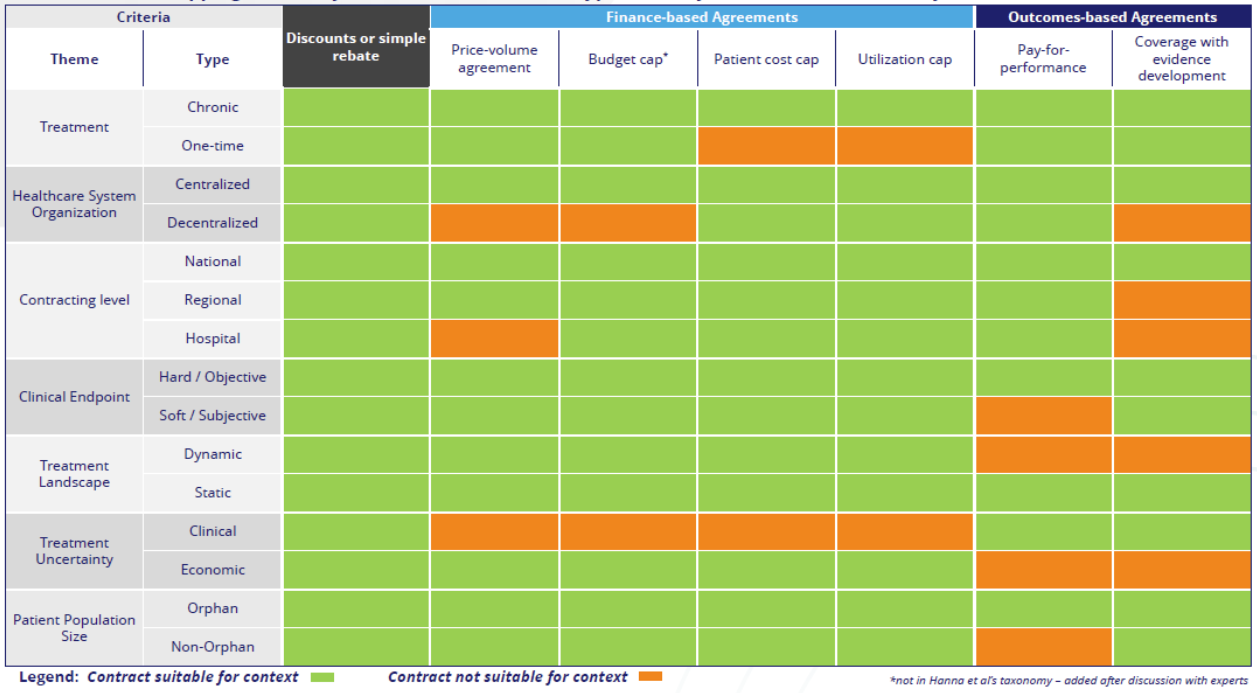Healthcare Outcomes Optimization: Conditions for Successful Value-Based Contracts
Value-Based Contracts (VBCs) are an umbrella term to describe various agreements between life sciences companies and healthcare payers to address products with high levels of financial and/or clinical uncertainty.
Our team has classified two major groups of innovative agreements that are used to address high levels of uncertainty when discounts or simple rebates are not sufficient:
- Financial-based agreements: price-volume agreement, budget cap, patient cost cap, utilization cap
- Outcome-based agreements: pay-for-performance, coverage with evidence development.
The uncertainty addressed by a VBC may arise from the ambiguity surrounding the cost or budget impact of a drug, particularly when the potential number of patients that will be treated is unclear. The drug’s performance can also be an area of uncertainty. For example, in scenarios where the clinical trial is comprised of a single arm without a comparator, payers may feel that there is too much uncertainty about how a drug will perform compared to existing treatments on the market.
The definition of “value” varies among stakeholders – payers, patients, and providers. But ultimately, VBCs aim to establish a link between what healthcare systems pay and the value that the drug provides. This marks a paradigm shift from traditional payment for services model. Noteworthy examples of countries that are successfully implementing VBCs include Italy, a pioneer in this area with its electronic patient registry, and the UK, leveraging managed entry agreements.
VBCs have the potential to mitigate the inherent financial and/or clinical uncertainties associated with making innovative drugs available for patients. This article explores the optimal conditions under which different types of VBCs are suitable to maximize success.
Identifying the Conditions for Successful VBCs
The success of a VBC is measured differently for different stakeholders, based on their definition of value. But ultimately, success can be measured by asking if using a VBC has reduced the uncertainty it was meant to address and brought numerous benefits to the stakeholders, including, but not limited to:
- Improved access to treatments
When the only way to reduce clinical uncertainty is to do a years-long clinical trial, patient access to that innovative drug is delayed. An outcomes-based agreement allows an appropriate population of patients to have access sooner. Also, the manufacturer can collect Real-World Data (RWD). Payers can then make future funding or pricing decisions based on the RWE. - Cost savings realized in the healthcare system
For example, with a finance-based agreement, you can set a certain threshold of patients treated and once that is reached, a discount kicks in. With outcomes-based agreements, you can agree that payment is tied to reaching certain clinical or patient outcome milestones. - Contribution towards building a sustainable healthcare system
Earlier access to the right patients means they can benefit from innovation and hopefully experience positive outcomes. And measurable cost savings across healthcare systems can have a powerful impact in this time of tight budgets. These building blocks can ensure sustainable healthcare systems where costs don’t skyrocket, payers are paying for value, and patients are receiving that value.
When used successfully, VBCs can improve patient access to innovative medicines and clinical outcomes, save costs and reduce budget impact, and ensure that all stakeholders in the healthcare system receive value.
Through our research, we have identified seven contextual factors that play a crucial role in determining the right VBC:
- Treatment administration (chronic or one-time)
- Healthcare system organization (centralized or decentralized)
- Contracting level (national, regional, or hospital)
- Clinical endpoint (hard/objective or soft/subjective)
- Treatment landscape (dynamic or static)
- Patient population size (orphan or non-orphan)
Our team developed this matrix to map the suitability of VBC types and analyze the key contextual factors.

The matrix revealed distinct implications for various contract types in different healthcare scenarios, including:
- Discounts and simple rebates are universally applicable across a spectrum of situations. This contract type’s simplicity in adjusting treatment prices, coupled with its capacity to provide budgetary predictability, makes it a versatile choice.
- The pay-for-performance VBC type demonstrated a more restricted applicability, aligning effectively with fewer contextual factors. The primary driver behind this limitation is the substantial cost and complexity associated with its implementation, particularly in clinical landscapes characterized by rapid evolution or a substantial patient load requiring monitoring.
- For treatments addressing chronic orphan conditions in a static clinical landscape and within a centralized healthcare system at the national level, all contract types were viable, contingent on the identified uncertainty.
In summary, the success of VBCs hinges on careful considerations of various factors such as the nature of treatment administration (chronic or one-shot), the organization of the healthcare system, the treatment landscape dynamics, and the characteristics of the patient population. While discounts and rebates demonstrate universal adaptability, the more nuanced applicability of pay-for-performance VBCs highlights the need for strategic alignment with all the factors. Ultimately, whether or not to implement a VBC depends on the type and level of financial and/or clinical uncertainty and the balance of simplicity offered by discounting or simple rebates against other, more complex agreements.
Learn More About Value-Based Contracts
If you would like to learn more about how to identify the right type of VBC, including details on the six types of VBCs analyzed for their suitability in different situations, download our poster, “Optimizing Healthcare Outcomes: Identifying the Conditions for Successful Value-Based Contracts” presented at ISPOR Europe 2023.
References
- Alira Health materials: report of 20 one-on-one interviews with payers from selected countries. Hanna et al.
Subscribe to our newsletter for the latest news, events, and thought leadership

